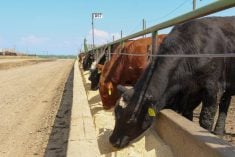As of the third week of September, Alberta packers were buying fed cattle on a live basis in the range of $180-$183/cwt delivered. Alberta finished cattle prices were rather flat throughout September. For March and April of 2023, feedlot operators have been able to forward-contract fed cattle on a dressed basis at $345/cwt delivered which equates to $207 on a live basis.
The U.S. and Canadian slaughter pace continue to exceed year-ago levels, and demand has held up better than expected throughout the summer. However, demand is expected to ease in the final quarter of 2022 and first quarter of 2023 due to rising interest rates, inflation and the year-over-year increase in energy prices.
Yearling prices have softened throughout September. In late September, higher-quality 800-pound yearlings have been trading in the range of $238-$242/cwt in central Alberta, down from the peak of $250-$255/cwt from the first week of September.
Read Also

Harvest wraps up and fall work begins
At the Eppich famly ranch in western Saskatchewan, the fall harvest was successful with few breakdowns, cows and calves have been sorted and a new tractor has arrived
Feedlot placements in the U.S. are coming in higher than anticipated. The reverse is true in Western Canada, with feedlot placements dropping sharply below year-ago levels through the summer. Early calf sales across the Prairies had 500-pound steers reaching the psychological level of $300/cwt, which is near historical highs. Barley prices are percolating higher, which has limited the upside in the feeder market.
Yearling and calf supplies outside finishing feedlots as of July 1 were down 278,000 head from year-ago levels. In addition to the lower-supply situation, demand is sharply higher than a year ago for two main reasons. First, Canadian feeder cattle exports from Jan. 1 through Sept. 10 were 161,075 head, up 81,000 head or 101 per cent from a year ago. Secondly, Canadian feeder cattle imports from the U.S. (mostly Holstein feeders) from Jan. 1 through July 31 were 120,796 head, down from 254,492 head. Western Canada is contending with a year-over-year decrease in feeder cattle supplies along with stronger exports and lower imports. This has set a positive tone to the calf market for the fall.
Cattle on feed in Alberta and Saskatchewan as of Sept. 1 were down 12 per cent from September 1, 2021. This was the first month this year when on-feed numbers were below a year ago.
Feedlots in Alberta and Saskatchewan have been contending with a backlog of market-ready supplies throughout the summer, which caused the Alberta fed cattle market to trade at a sharp discount to values in Nebraska. During mid-September, Alberta packers were buying cattle for late October or even early November delivery. This will change in December when supplies of market-ready finished cattle in Western Canada will drop below year-ago levels. The Alberta fed cattle market is expected to trade at a premium to U.S. prices in the first quarter of 2022 as the market will need to ration demand away from export channels.
The Canadian dollar dipped to US73.50 in late September, which was a two-year low. The U.S. Federal Reserve and the Bank of Canada have been increasing their key lending rate in an effort to curb inflation, which has been running near 40-year highs. From June through August, Canada lost 104,000 jobs while U.S. non-farm payrolls expanded by 1.1 million jobs.
Energy prices have softened and wages are now a main factor contributing to inflation. It now looks like interest rate hikes from the Bank of Canada will peak sooner and at a lower level compared to the U.S. Federal Reserve. This has put a bearish spin on the Canadian dollar. A weaker Canadian dollar will continue to support fed and feeder cattle prices in the fall and winter. Rising interest rates may cause beef demand to soften due to a decline in consumer spending. A decline in disposable incomes on both sides of the border will eventually curb beef demand.
Feed barley prices up
Lethbridge-area feedlots were buying feed barley in the range of $390-$400/tonne delivered in latter half of September, up from the August lows of $350-$360/tonne. Canadian barley production will likely reach 9.9 million tonnes, up from the 2021 output of only 6.9 million tonnes. Despite the year-over-year increase in production, available supplies are rather tight due to the large barley export program to China in the first half of the crop year.
U.S. feedlot placements during the summer were similar to last year. Earlier in summer, we were expecting U.S. feeder cattle supplies in the fall period to be down sharply from year-ago levels due to the lower calf crop. We were expecting the U.S. feeder market to trend higher during the fall as U.S. cow-calf producers held back on heifers to encourage herd expansion. This view has slightly changed.
Over the past two years, feeder cattle on small-grain pastures in Texas, Oklahoma and Kansas were 1.7 million head. The U.S. Southern Plains continue to have drought-like conditions. U.S. feeder cattle moving onto small-grain pastures this fall could be down as much as 30 per cent. Tighter feed and forage supplies will also discourage heifer retention in the Southern Plains. U.S. cattle-on-feed numbers over the winter will be slightly higher than earlier projections. April live cattle futures were trading up to $160 in mid-September, which is only about $10 from the historical highs in November 2014.
The western Canadian feeder market is contending with tighter supplies. The weaker Canadian dollar has curbed imports and enhanced exports. This will result in lower feedlot placements in Western Canada throughout the fall. Barley prices are ratcheting higher, which has tempered the upside in the feeder market. Alberta and Saskatchewan market-ready fed cattle supplies are expected to be down sharply from a year ago. We’re expecting the Alberta fed cattle market to trade at a premium to U.S. values in the first quarter of 2023.
















